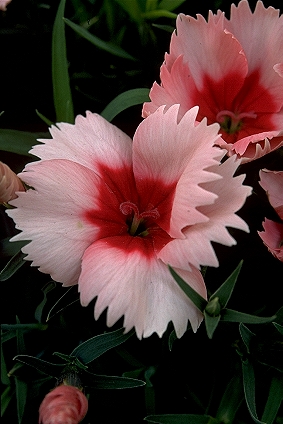 Clove pinks, pinks, sweet William, carnations and gillyflowers -all part of the delightful dianthus family.
Clove pinks, pinks, sweet William, carnations and gillyflowers -all part of the delightful dianthus family.
Dianthus means flower of flowers (or more literally god of flowers: dios (god) and anthos (flower)), a name bestowed on this herb by the Greeks and dedicated to their “sky father”. It was held in high regard with the Romans too, and the common name carnation probably stems from the misspelling of the word coronation, as dianthus flowers were often woven into coronation crowns and held a place of honour in floral displays.
A favourite in gardens for their fragrance as well as their colourful blooms – with all the tones from white to dark red, there are many varieites of dianthus available.
Perennial 15-60cm in height; 30cm spread Prefers well-drained alkaline soil Sunny position Propagated by seed, division or cuttings
Use as an edible flower
From th e old Elizabethean gillyflower, the original parent of carnations, to the garden pinks or sweet Willies, all the sweetly clove scented Dianthus flowers are edible. It is often recommended to remove the bitter white heel from the petals before use.
e old Elizabethean gillyflower, the original parent of carnations, to the garden pinks or sweet Willies, all the sweetly clove scented Dianthus flowers are edible. It is often recommended to remove the bitter white heel from the petals before use.
They make a delightful garnish over sweet and savory dishes alike, and can be floated in wine, cordials and other drinks or frozen in ice cubes, but they are also often used to lend a soft spicy sweetness to many dishes such as sauces, soups, syrups, jams & jellies, fruit pies, vinegars and salads. They can be candied very successfully and also pickled.
Recipes
- Gillyflower tuile ice cream bowls
- Mushroom Fettucine with Pinks
- Pinks in Fruit Salad with Creme Fraiche
Simply mix sweet william flowers into your selection of fresh fruit, and mix petals into vanilla creme fraiche on the side. Delightful! - Clove pink syrup
Infuse 2/3 cup of flowers overnight in 1 cup warm sugar syrup (1 part sugar to 1 part water)
